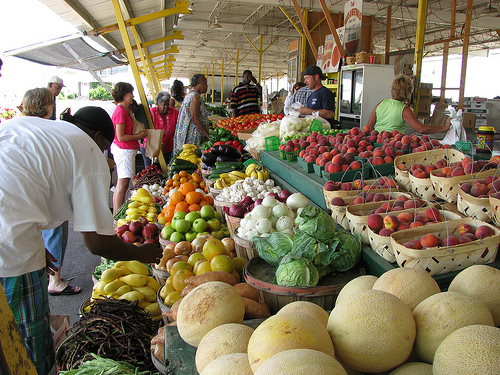
This is the third post in a multi-part blog series analyzing the draft farm bill released on April 12, 2018 by House Agriculture Committee Chairman Mike Conaway (R-TX). Other posts in this series focus on: beginning and socially disadvantaged farmers, crop insurance and commodity subsidies, research and seed breeding, conservation, and organic agriculture. The bill is expected to be considered and “marked-up” (aka amended) by the full Agriculture Committee this week and on the House floor in May.
Consumer demand for local and regional products is on the rise, and this growing interest has helped to develop a “farm to fork pipeline,” through which farmers, food-related businesses, and consumers can connect. While this growing industry is full of opportunities for farmers and entrepreneurs throughout the food chain, many still struggle to break into the marketplace because of persistent and significant barriers to entry. Helping to connect the dots between farmers and new markets by investing in local and regional food systems creates economic opportunity throughout the food chain, and increases American families’ access to healthy foods.
The draft bill recently released by House Agriculture Committee Chairman Mike Conaway (R-TX) unfortunately fails to help American farmers tap these growing markets – in fact, the bill actively undermines the very programs and systems that have been the shining stars of the local and regional food renaissance.
Over the last year, numerous members of Congress have introduced proposals to build upon successful programs and grow farm to fork opportunities. The Local Food and Regional Market Supply (FARMS) Act (H.R. 3941), for instance, was introduced by Representatives Chellie Pingree (D-ME), Jeff Fortenberry (R-NE), and Sean Patrick Maloney (D-NY) and currently has 16 bipartisan cosponsors in the House. This bill includes numerous provisions to breakdown barriers to entering the local and regional food economy, and would strengthen rural and urban communities with farm to fork investments. Unfortunately, the Chairman’s mark ignores such proposals, instead choosing to turn back the clock on nearly two decades of investments and industry growth.
Below, we include a summary of the key takeaways on how the Chairman’s mark approaches local and regional food system and rural development programs.
Highlights
- Substantially increases mandatory funding for the Food Insecurity Nutrition Incentives Program — provides $275 million over 5 years, $600 million over ten years, and establishes permanent baseline for the program.
- Gives USDA the authority to conduct up to five pilot projects, which would test how SNAP recipients might better use mobile technology to redeem benefits. These pilot projects could end up revealing new and effective methods for direct market farmers selling through farmers markets, CSAs and other direct marketing opportunities to accept SNAP benefits.
Mixed Bag
- Requires that the U.S. Department of Agriculture’s (USDA) Food Safety and Inspection Service conduct a study and report on the effectiveness of current outreach and guidance geared toward small and very small processing plants. This report would also include recommendations on actions the agency should take to improve regulatory clarity and consistency for small and very small plants. While the report is sure to provide important insights, the change falls short of the actionable directives recommended by the sustainable agriculture community.
- Reauthorizes the Senior Farmers Market Nutrition Program, but fails to include a proposed expansion to add low-income veterans as a beneficiary of the program, along with a commiserate increase in funding. The program was provided with flat funding at $20.6 million per year in mandatory funding.
- Reauthorizes the Food Safety Outreach Program, but does not provide any mandatory funding. Proposed policy changes that would have enhanced community-based organizations’ ability to access the program were not included in the bill.
Lowlights
- Effectively eliminates the Farmers Market and Local Food Promotion Program by providing no mandatory funding. The 2014 Farm Bill provided the program with $30 million per year in mandatory funding.
- Effectively eliminates the Value-added Producer Grants Program by providing no mandatory funding. The 2014 Farm Bill provided the program with $63 million to be spent over 5 years.
- Effectively eliminates the National Organic Certification Cost Share Program by not reauthorizing or providing the program any funding.
- Eliminates all mandatory funding and baseline for the Rural Energy for America Program. The 2014 Farm Bill provided the program with permanent baseline funding of $50 million per year.
- Effectively eliminates the Rural Microentrepreneur Assistance Program by providing no mandatory funding. The 2014 Farm Bill provided the program with $3 million per year in mandatory funding.
- Fails to include the proposed Food Safety Cost-share Program, which would support specialty crop producers in accessing new markets and attaining compliance with the Food Safety Modernization Act’s new regulations for produce farms.
- Rejects support for farm-to-school initiatives by not including provisions to provide regulatory flexibility around the use of geographic preference for school food procurement.
- Does not include the proposed Harvesting Health Pilot Program, which would demonstrate and evaluate the impact of produce prescription programs.
- Does not include the proposed Regional Food Economy Partnership Program, which would establish a private-public partnership program focused on regional food systems planning and development projects that could leverage outside investment and expertise from financial institutions, foundations and NGOs.

